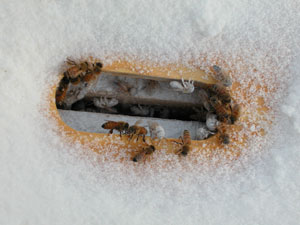 You've seen me going on and one about the two main winter beekeeping issues around here: food stores and mites. This is the most interesting picture I could show you about how I've been trying to look after both.
You've seen me going on and one about the two main winter beekeeping issues around here: food stores and mites. This is the most interesting picture I could show you about how I've been trying to look after both.This is a peek through the inner cover of the Wilde colony on my roof. The bees inside are covered in powdered sugar, and the cover itself is holding about 4 pounds of granulated cane sugar. The powdered sugar is a non-toxic mite control method: the varroa mites seem to be unable to hang onto powdered bees, and they fall off (hopefully leaving the lives of the bees altogether). The bees soon clean themselves off, and get a bit of a snack in the bargain. MaryEllen (the beekeeper, not the colony) points out that this method is kind of like flossing your teeth, though: you need to do it over and over to get much benefit.
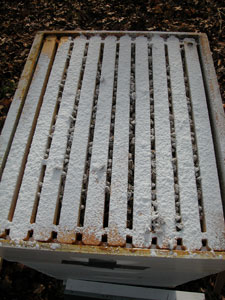 Very soon after sugaring up the bees, white-covered bees began emerging from the hive entrances, though this is just a close up from the top of a hive. To properly apply the sugar, you should remove each box, powder the top, place the next box on top, powder it, and so on. I am afraid to manipulate the bees much in cold weather: I could break the cluster, or expose the queen, or do some other typically awkward thing at a time when the bees have few options. So, for the sake of doing something, I put on the powder and then made another oxalic acid application.
Very soon after sugaring up the bees, white-covered bees began emerging from the hive entrances, though this is just a close up from the top of a hive. To properly apply the sugar, you should remove each box, powder the top, place the next box on top, powder it, and so on. I am afraid to manipulate the bees much in cold weather: I could break the cluster, or expose the queen, or do some other typically awkward thing at a time when the bees have few options. So, for the sake of doing something, I put on the powder and then made another oxalic acid application.  The granulated sugar is a winter feeding method suggested by a beekeeper at the state meeting last month. Bees often stop taking sugar syrup when the temperature reaches freezing, but they will (apparently) creep up on the inner cover and grab some dry sugar when the need arises. You can put a shim on top of the cover, and then place the telescoping cover. I'm a little unsure of whether this is worthwhile, for a couple of reasons. The first is that I don't personally know any beekeeper who does this, and the second is that the bees will need some source of liquid water in order to access the sugar as a food source. This latter is also a concern when offering them fondant (bee candy), however, and I know that they take fondant just fine.
The granulated sugar is a winter feeding method suggested by a beekeeper at the state meeting last month. Bees often stop taking sugar syrup when the temperature reaches freezing, but they will (apparently) creep up on the inner cover and grab some dry sugar when the need arises. You can put a shim on top of the cover, and then place the telescoping cover. I'm a little unsure of whether this is worthwhile, for a couple of reasons. The first is that I don't personally know any beekeeper who does this, and the second is that the bees will need some source of liquid water in order to access the sugar as a food source. This latter is also a concern when offering them fondant (bee candy), however, and I know that they take fondant just fine.As an example, here are two pictures of fondant. The first is a flower-shaped (broken) brick of bee candy newly placed on the Cockrill hive at the mill. The second is a picture of a brick of fondant MaryEllen put on the neighboring Millard hive a week or so before. Chew chew chew!
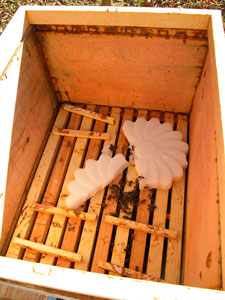

At the state meeting, the most experienced beekeepers agreed about one thing, as winter approaches: after 100 million years, bees don't freeze to death during winter, they starve. We've had warm temperatures, and I have seen bees flying almost every day and only the rarest of flowers in bloom. Though applying the oxalic acid to save the bees from mites will require 15 unique applications, it appears that far more of my time will be spent this year dishing out the sugar.
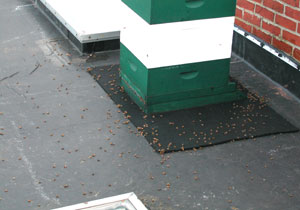
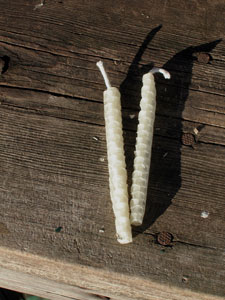 Surprise, surprise: the bees are the lens through which I see the midwinter festivities now, and our celebrations are brightened (even literally) by the bees' presence and presents.
Surprise, surprise: the bees are the lens through which I see the midwinter festivities now, and our celebrations are brightened (even literally) by the bees' presence and presents. But we have an equal opportunity attitude to holidays around here, so I was also noodling around with bee-based gift baskets, and figured out an interesting way to present the three different colors of honey produced by the roof, monastery, and mill apiaries this year. MaryEllen gave me some special pastry plastic, and I taped together "flights" of honey: the lightest from the monastery, the medium from the roof, and the darkest from the mill. I also labeled some single-source jars for people whom might just like to have a usable amount of a single honey (rather than three somewhat impractical samples).
But we have an equal opportunity attitude to holidays around here, so I was also noodling around with bee-based gift baskets, and figured out an interesting way to present the three different colors of honey produced by the roof, monastery, and mill apiaries this year. MaryEllen gave me some special pastry plastic, and I taped together "flights" of honey: the lightest from the monastery, the medium from the roof, and the darkest from the mill. I also labeled some single-source jars for people whom might just like to have a usable amount of a single honey (rather than three somewhat impractical samples). 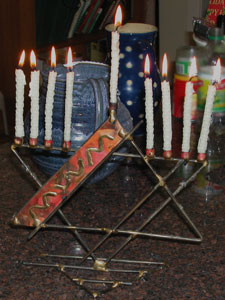 With apologies for the blown-out quality of these pictures, here's our final result. The menorah looked homey and glorious with the beeswax candles, though they did not burn as long as expected. The gift baskets included honey, candles, soaps, and a bag of Honey Pecan "Crackerjack," a first-time thing for me that seems to have come out OK. The recipe is below (with instructions about embellishments in parentheses).
With apologies for the blown-out quality of these pictures, here's our final result. The menorah looked homey and glorious with the beeswax candles, though they did not burn as long as expected. The gift baskets included honey, candles, soaps, and a bag of Honey Pecan "Crackerjack," a first-time thing for me that seems to have come out OK. The recipe is below (with instructions about embellishments in parentheses). All this craftiness was intended to simplify and refocus this special time, though it must be said that gift baskets are way more time consuming and kitchen-destroying than a trip to the mall. It's hard not to hope rather TOO hard that people will particularly like the effort, and perhaps to get too personally wrapped up in it all. After all, even when the goodies come from the girls, it is not about the stuff.
All this craftiness was intended to simplify and refocus this special time, though it must be said that gift baskets are way more time consuming and kitchen-destroying than a trip to the mall. It's hard not to hope rather TOO hard that people will particularly like the effort, and perhaps to get too personally wrapped up in it all. After all, even when the goodies come from the girls, it is not about the stuff.